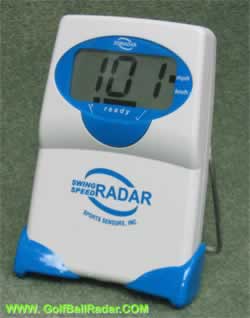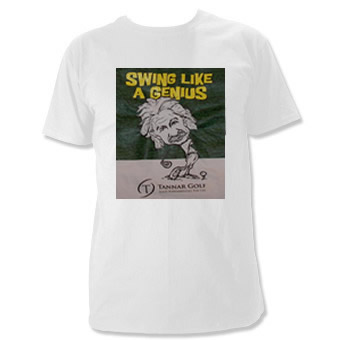
|
|
|
How much energy to you burn playing golf? That energy can translate into calories of food that you have consumed. Obviously, you'll burn more calories if you walk, as opposed to riding a golf cart. Plus, the farther you walk, the more calories you'll burn (criss crossing fairways looking for balls). So, here's some science behind how many calories you can burn while playing golf. Firstly, the golf swing.Nesbit and Serrano's paper "Work and Power Analysis of the Golf Swing" was published in a 2005 Journal of Sports Science and Medicine. In the paper, they outlined a study of the 3D mechanics of the golf swing using an energy based apporach. They calculated the energy required to swing for 4 different golfer types. The energies are in the table below using units of Calories.
The human body is a type of machine. As a machine, it is not 100% efficient, which would mean requiring 1 Calorie of energy to do 1 Calorie of work. The human body is actually quite inefficient due to the amount of body heat generated due to normal metabolism and exercise. Efficiencies range from about 5% (average person) to 25% (a well conditioned athlete). If we assume an efficiency of 10% for golfers, the food energy required to do work can be calculated by dividing the work by 0.10. Thus, the calories "consumed" by the body to swing a golf club is tabulated in the 2nd row.
The table above is for a full swing. A Male Scratch player would make approximately 36 full swings (3 on the 4 par 5s, 2 on the 10 par 4s and 1 on the par 3s) in an 18 hole round of golf. Of course, a player might hit a provisional ball a few times in a round (due to a potential lost ball) or need to hit extra full shots because of errant shots. Let's assume, therefore, that the Male Scratch would make 40 full swings, on average, during a round. Thus, 40 swings at 3.5 Calories per swing equals 140 Calories. Not even equivalent to a chocolate bar. A Male 13 Handicap would take more full swings, but would utitlize less energy per swing, as would the Female 18 Handicap. In conclusion, one will not consume many calories by swinging a golf club in around of golf.
Secondly, walking.So, what about walking. If you get online, you'll find a multitude of calculators that will tell you how many calories you'll burn during different types of activities. I'm not sure I would trust those, as I found some major discrepancies. All the calculators I found assume that the amount depends on the weight of the person. Recent scientific studies, however, refute this assumption. Published in "The Journal of Experimental Biology", Peter Weyand of Southern Methodist University reported the results of his study of energy burned while walking on a flat surface. His subjects ranged from 5 to 32 years old, weighing between 35 to 195 pounds, from 3.5 to 6 feet tall. He had them walk as slow as 0.9 mph and as fast as 4.2 mph. He simulataneously measured the walkers' oxygen consumption and carbon dioxide production rates to obtain their total metabolic rate. In analyzing the walkers' styles, he found that all moved in exactly the same way regardless of their height. Essentially, if you scaled a 5 year old up to 6 feet in height, the giant child would walk in exactly the same way as a 6 foot tall adult. So, large people are not more economical in the way they walk than smaller people. Weyland concluded that the energy burned per stride was basically the same for all subjects, regardless of their height or weight. Thus, short people tend to burn more calories while walking than tall people, for only the reason that they take more strides. Weyland formulated an equation for energy burned to be: 2.7 Joules per stride per kg of mass. Since taller people have longer strides, they can travel further for the same amount of energy per kg of mass, thus, they are more economical walkers. Weyland and his team determined that the amount of energy per metre walked on a level surface to be approximately 3.8 times mass divided by height (actual = 3.80M/H^0.95). Using this equation, a child with mass 15.9 kg (35 lb) and height 1.07 metre (3.5 ft) would burn 57 Joules per metre (0.0136 Calories per metre). On a 6500 yard golf course, one would walk about 7500 to 8000 yards (depends on distance between tee boxes and the amount of zig zagging on each hole (looking for errant balls). Let's assume 8000 yards which equates to 7340 metres. The child would use 7340 X 0.0136 Cal = 100 Calories. A 88.7 kg (195 lb) adult with 6 ft height would burn 190 J/m (0.045 Cal/m). On the same course, this adult would use 7340 X 0.045 Cal = 332 Calories. A 100 kg (220 lb) adult with a 6 ft height would burn 214 J/m (0.051 Cal/m) and thus would use 374 Calories, not that much more than the lighter adult. So, on a level golf course, one can assume an average size male golfer would burn about 300 Calories. An above average male would burn closer to 400 Calories, while swinging burns about 140 Calories. Walking definitely makes a significant difference in calories burned. If you play and hilly golf course, walking can make even a bigger difference. Let's say you play a course whose topography is up and down. Everytime you need to climb uphill, your body will do more work and thus burn more calories. If one assumes say 9 uphill climbs (half the holes) of 60 feet or about 20 metres. The change in gravitational potential energy, GPE = mgh (m = mass in kg, g = 9.80 and h = 20 m) = 17 385 Joules = 4.1 Calories of an 88.7 kg golfer. Assuming a 10% efficiency, the golfer would burn 41 Calories. For 9 such climbs, the total would be 370 Calories. The heavier the golfer, the more calories will be burned for uphill climbs. In summary, the calories burned during a round of golf for a 195 lb adult would be about: Take a power cart and burn only 140 Calories for full swing shots Walk a level golf course and burn an additional 332 Calories Walk a hilly golf course and burn an additional 370 Calories The heavier the golfer, the more calories burned, especially on hilly golf courses. Walking is a great way to burn calories along with the benefit of some good healthy exercise. I encourage you to walk as much as possible. And, you'll actually burn more calories the faster you walk. So, let's burn more calories and speed up the pace of play.
©Probable Golf Instruction, Ken Tannar 2001-2015. All Rights Reserved. Langley, B.C. V2Y 2G4 CanadaPhone: 604-309-7030 FAX: to fax, email an attachment probablegolf@yahoo.ca or golfexpert@probablegolfinstruction.com |
| GOLF ASSISTANTS |
|
Golf Trip Pairing CalculatorPlanning a golf trip with some friends/family? Trying to sort out the foursomes so people don't play too often with others? Order your ready made Spreadsheet. Type in the names, print out the groupings. Minimize repeat pairings.
Wind Caddy will advise you on aim, distance and club so that you can play the wind successfully. It takes the guess work out of club selection. New option to enter custom distances for each club. The algorithm will make a club suggestion accordingly. Use the right club in every condition!
|
|
|
| GOLF NEWS |
Golf Putting Green Reading Glasses |
| GOLF NEWSLETTER |
Statistics
·Putting
·Longest Golf Balls
·Games
·Handicap
·Scoring
·Shot Patterns
·Tournaments
·PGA Tour Stats
Pro Shop
·Ball Marker Engraved
·Books
·CDs & DVDs
·Green Reader
·Impact Labels
·Laser Rangefinder
·Longer Drives
·Products
·Teaching Aids
|
|
| GOLF POLL |
The 19th Hole
·Advertising
·Ask the Golf Expert
·Consultation/Litigation
·FAQs
·Golf Blog
·Golf Draws
·Links
·Science of Golf
·Tell a Friend
·Testimonials
·

Golf Ball Finder Glasses
Find all your errant golf balls and many more!
| GOLF TIPS |
How to play:
|




